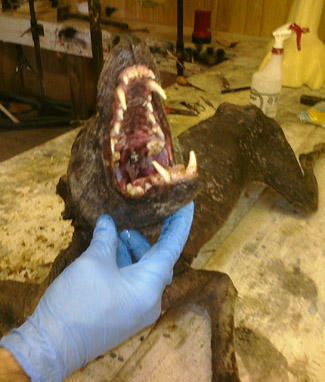

Famous Cases | Historical Tales | Vampires | Zombies
 |  |
Famous Cases | Historical Tales | Vampires | Zombies |
9/2/09
Tony Pierce
The Los Angeles Times
 |
| Chupacabra? Mexican hairless? Photo credit: Robert McDaniel |
"The phone has been ringing off the hook" at the Blanco Taxidermy School, Robert McDaniel, the chief instructor, told The Times on Wednesday. The news media and the curious -- "Good Morning America" among them -- have called in asking for interviews and to find out if they have really found a chupacabra. "We've gotten about 100 calls today," he said.
The interest is all about a dead, hairless, coyote-like creature that was captured by Lynn Butler, a former student at the school. According to McDaniel, Butler heard something in his cousin's barn "tearing up the chickens pretty bad. So he left poison out thinking it was a raccoon or other varmint." The next day he found the lifeless animal that many claim is a chupacabra.
Jerry Ayer, owner of the Blanco Taxidermy School, isn't so sure that what he has really is what everyone hopes he has. But as the man who is in the process of stuffing the beast, he does know he's working on something unique.
"To be honest, I don't know what it is. I'd probably say it's a freak-of-nature coyote, or a hybrid breed with a genetic mutation," the soft-spoken Ayer said.
Ayer says he stuffs about 15 to 20 coyotes a year, and this is no coyote. "The footpads are different. They're rather bulbous. And this has longer legs by a few inches."
But what makes it so different from other coyotes or dogs is that it is mostly hairless. "It has a little fuzz around the feet," Ayer says. "Almost like little socks of fur. And there's a little hair up the backbone. Very odd-looking."
Clearly intrigued by the creature's abnormalities, Ayer continues, "The hairlessness is sinister because you can see the bones protruding at the hips."
It's that creepy look and scavenger-like behavior that Ayer believes leads people to buy into the myth. "These types [of animals] will zip in and out of people's backyards and eat anything live or dead. They have two big canine teeth in the front and they go for the neck." When someone hears the animal and goes out back with a flashlight to investigate, "They see this weird-looking dark creature running off. And they see two holes in the side of the neck of a goat, and they take it from there."
What they take it for is a chupacabra, whether Ayer agrees or not. "It doesn't matter what I call it," Ayer says. "It's been labeled."
But one thing does matter to Ayer. "I don't want to be known as the chupacabra quack," he said by telephone. "People say there's a mythical beast and [that] I have one. I'll call it chupacabra because people love it, but I don't know what it is."
Two universities might help identify exactly what Ayer has. He said he has received requests from the University of Texas and UC Davis to provide tissue samples for their ongoing research.
And what of the possibility that a chupacabra might make an appearance locally -- say, at the Los Angeles Zoo? Asked if the zoo would house a chupacabra if one was captured, Jason Jacobs, the zoo’s marketing and public relations director, put off the issue as a matter of conjecture. "We don't have scientific proof that one exists," Jacobs noted.
Meanwhile, as the university scientists conduct their studies, the careful craft of taxidermy is being performed in Central Texas.
McDaniel and Ayer, who are half-brothers, say they have no immediate plans to charge admission to view the animal once it is properly stuffed and mounted; they're just happy that it is bringing attention to the taxidermy school. (According to McDaniel, for $3,500 the school will provide all the education anyone would need to become a professional taxidermist.)
Once the mounting is complete, Ayer says, he plans on displaying it at the school. But he'll store it at night in a safe place -- because, he says, he's sure something as rare as whatever he has would be quite valuable to thieves.